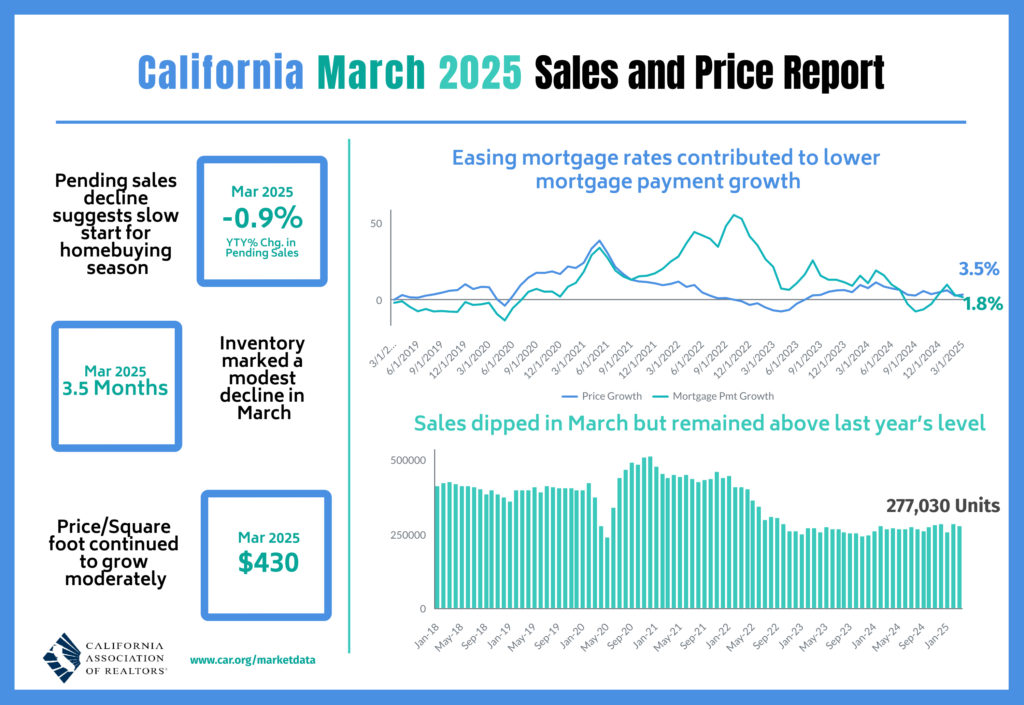- Existing, single-family home sales totaled 277,030 in March on a seasonally adjusted annualized rate, down 2.3 percent from 283,540 in February and up 4.9 percent from 264,200 in March 2024.
- March’s statewide median home price was $884,350, up 6.7 percent from February and up 3.5 percent from $854,370 in March 2024.
- Year-to-date statewide home sales were up 1.9 percent.
LOS ANGELES (April 17) – California home sales dialed back slightly in March as consumers grow increasingly concerned about their financial outlook in the year ahead, the CALIFORNIA ASSOCIATION OF REALTORS® (C.A.R.) said today.

Closed escrow sales of existing, single-family detached homes in California totaled a seasonally adjusted annualized rate of 277,030 in March, according to information collected by C.A.R. from more than 90 local REALTOR® associations and MLSs statewide. The statewide annualized sales figure represents what would be the total number of homes sold during 2025 if sales maintained the March pace throughout the year. It is adjusted to account for seasonal factors that typically influence home sales.
March’s sales pace fell 2.3 percent from the 284,540 homes sold in February and was up 4.9 percent from a year ago, when a revised 264,200 homes were sold on an annualized basis. Despite a continued bounce back in sales since the beginning of 2025, the level of homes sold remained below the 300,000 mark for the last 30 months. With tariff threats and recession fears growing and home buyer optimism fading, home sales could remain soft in the months ahead.
Pending home sales across the state declined in March for the fourth straight month, reflecting continued weakening in housing sentiment. Fluctuating mortgage rates and rising recession fears likely contributed to the drop in demand. With rates expected to remain volatile, pending sales may stay soft as the spring homebuying season begins.
“Home sales slowed in March as both buyers and sellers grew more concerned about the ongoing tariff situation and its potential impact on their personal finances,” said C.A.R. President Heather Ozur, a Palm Springs REALTOR®. “With uncertainty weighing on those still striving for the American Dream, this is an important time for REALTORS® to use their expertise to guide clients through the challenges.”
The March statewide median price climbed 6.7 percent from $829,060 in February to $884,350 in March and 3.5 percent from $854,370 in March 2024. The year-over-year increase was the 21st straight month of price gains, but the improvement continued to be mild. On a monthly basis, the March median price jumped from the prior month, but the monthly improvement was slightly below the 10-year historical average increase of 7.7 percent recorded between February and March. The statewide median price should continue to climb in the next few months if it follows its seasonal pattern, but price growth in the second quarter could remain modest as market uncertainties and economic concerns linger on.
“Despite mortgage rate swings and financial market volatility, housing conditions remained stable in March,” said C.A.R. Senior Vice President and Chief Economist Jordan Levine. “Although slower open-escrow sales point to a sluggish start for the spring season, increased inventory and modest price growth offer hope for buyers seeking more options and improved affordability.”
Other key points from C.A.R.’s March 2025 resale housing report include:
- Sales in three of the five major California regions declined from a year ago on an unseasonally adjusted basis, while sales in the other two increased mildly. The Central Coast region recorded the biggest sales drop from last year with a decrease of 6.7 percent in sales, followed by the Far North (-1.2 percent) and Southern California (-0.4 percent). Sales of existing single-family homes continued to climb year over year in the San Francisco Bay Area with a strong 6.5 percent increase as three out of nine counties in the region posted a double-digit sales surge from a year ago. Sales in the Central Valley region (2.5 percent) also inched up from last year, but the increase was not as robust.
- Thirty-one of the 53 counties tracked by C.A.R. registered sales increases from a year ago, with more than half (17) of them surging by more than 10 percent on a year-over-year basis. Siskiyou (44.4 percent) posted the sharpest sales increase from a year ago, followed by Tehama (40 percent) and Tuolumne (40 percent). Home sales declined from last year in 20 counties, with sales in 10 of them falling by more than 10 percent. Del Norte (-61.1 percent) registered the biggest sales drop in March, followed by Trinity (-60 percent) and Mariposa (-48 percent). All three counties have had a rough first quarter so far this year, with sales in each of them dropping by more than 25 percent on a year-to-date basis for the first three months of 2025.
- At the regional level, all five major California regions registered a median price increase from last year, but the increases were mild except for one region. The Central Coast region, again, had the largest price growth from a year ago at a jump of 16.6 percent, as prices in both Santa Barbara and San Luis Obispo counties within the region surged by double-digits. The Central Valley (3.4 percent) came in second, followed by the Far North (3.4 percent), Southern California (3.3 percent) and the San Francisco Bay Area (1 percent).
- Home prices increased on a year-over-year basis in three-fourths of the California counties, with March’s median sales prices rising from their year-ago levels in 39 of the 53 counties tracked by C.A.R. Mendocino (48.2 percent) posted the biggest price jump of all counties last month, while prices in both Santa Barbara (38.8 percent) and Tehama (24 percent) surged from their year-ago levels by more than 20 percent. Thirteen counties registered a drop in their median price from a year ago, with Del Norte falling the most at 51.5 percent, followed by Plumas (-27.5 percent) and Mariposa (-18.3 percent).
- Following the typical seasonal pattern, March’s unsold inventory index (UII) declined from the prior month as sales pace picked up at the end of the first quarter. The statewide Unsold Inventory Index (UII), which measures the number of months needed to sell the supply of homes on the market at the current sales rate, dipped month over month but grew solidly from its year-ago level as more new listings hit the market. The index was 3.5 months in March, down from 4.0 months in February and up from 2.6 months in March 2024.
- Total active listings in March rose on a year-over-year basis at the fastest pace since January 2023. The level of active listings last month reached a six-month high and recorded the 14th consecutive month of annual gains in housing supply.
- New active listings at the state level rose year-over-year by double-digits for the third consecutive month, as more sellers began to list properties on the market. Newly added units also surged more than 20 percent from the previous month after dipping slightly in February. As of now, the unusual month-to-month dip in February looks more like a temporary hiccup due to the recent financial market volatility, rather than a reflection of the concern of the economy’s well-being.
- The median number of days it took to sell a California single-family home was 22 days in March, up from 18 days in March 2024.
- C.A.R.’s statewide sales-price-to-list-price ratio* was 100 percent in March 2025 and 100 percent in March 2024.
- The statewide median price per square foot** for an existing single-family home was $430, up from $424 in March a year ago.
- The 30-year, fixed-mortgage interest rate averaged 6.65 percent in March, down from 6.82 percent in March 2024, according to C.A.R.’s calculations based on Freddie Mac’s weekly mortgage survey data.
Note: The County MLS median price and sales data in the tables are generated from a survey of more than 90 associations of REALTORS® throughout the state and represent statistics of existing single-family detached homes only. County sales data is not adjusted to account for seasonal factors that can influence home sales. Movements in sales prices should not be interpreted as changes in the cost of a standard home. The median price is where half sold for more and half sold for less; medians are more typical than average prices, which are skewed by a relatively small share of transactions at either the lower end or the upper end. Median prices can be influenced by changes in cost, as well as changes in the characteristics and the size of homes sold. The change in median prices should not be construed as actual price changes in specific homes.
*Sales-to-list-price ratio is an indicator that reflects the negotiation power of home buyers and home sellers under current market conditions. The ratio is calculated by dividing the final sales price of a property by its original list price and is expressed as a percentage. A sales-to-list ratio with 100 percent or above suggests that the property sold for more than the list price, and a ratio below 100 percent indicates that the price sold below the asking price.
**Price per square foot is a measure commonly used by real estate agents and brokers to determine how much a square foot of space a buyer will pay for a property. It is calculated as the sale price of the home divided by the number of finished square feet. C.A.R. currently tracks price-per-square foot statistics for 53 counties.
Leading the way…® in California real estate for nearly 120 years, the CALIFORNIA ASSOCIATION OF REALTORS® (www.car.org) is one of the largest state trade organizations in the United States with more than 200,000 members dedicated to the advancement of professionalism in real estate. C.A.R. is headquartered in Sacramento
